
In 1962, 61 years ago, President John F. Kennedy promised to put a man on the moon before the decade was out. Now NASA has announced that humans will be living and working there within the next 10 years, an ambition that is starting to look more achievable with the recent successful landing of a spacecraft and a robotic explorer from India on the lunar south pole.
It is the first time that a human being has set foot on the soil of the South Pole of the Moon, a very important fact as space agencies in this region organize manned missions and establish at least the first bases and subsequent colonies.
Water is proposed to exist in frozen form beneath the surface of the Moon’s south pole, and all major space agencies are organizing manned and unmanned missions there.
Finding and then successfully recovering and exploiting frozen water would greatly aid in establishing viable manned facilities of any kind on the Moon. The frozen water could produce drinking water, oxygen, and even rocket fuel for lunar residents who would not otherwise rely entirely on supplies from Earth. Permanent habitation on the Moon would be one of the most difficult things humanity has ever done, and raises many urgent questions.
First of all, where could such a settlement be on the moon? Not every place on our friendly satellite is equal when it comes to settling there. Thanks to its orbital path, the Moon has a long night cycle, with each day or night lasting longer than two weeks on Earth.
This means that the most likely place for human settlement is near one of the poles, where there is only constant light and the differences between temperature extremes are much less sharp than in the tropics.
Two specific locations frequently cited by scientists are Mount Malaparte, near the Moon’s south pole, and the Berry Crater rim to the north.
Experts from NASA’s Goddard Flight Center say that Mount Malaparte contains huge reserves of hydrogen and the sun. The rim of Perry Crater (named after polar explorer Robert Peary) features large flat areas but also four mountainous areas on the rim, known as the Peaks of Eternal Light, that remain bright throughout the lunar day. This light source means relatively constant temperature and solar energy.
After choosing a site, creating the accommodation is the next step. Accommodations could be created either under the moon’s surface in tunnels created by past volcanic activity or in surface dwellings that could be built using robotic systems from local materials and 3D printers.
Underground dwellings have the advantage of greater protection from meteorite impacts and solar radiation, which is about 200 times stronger on the Moon than on Earth.
But penthouse dwellings offer ease of access and transportation, not to mention the mental satisfaction of being on the “outside.” It is possible to find a solution that is a combination of the two proposals.
Raw materials and supplies
Lunar buildings can be created using 3D printing technology, using regolith (lunar dust) as the basic building material: it contains aluminium, silicon, iron, calcium, magnesium and titanium.
Like any city on Earth, settlements will need energy and food supplies. Where will they be?
The first would come from a combination of solar energy (hence the need to be near the poles) and water (split into its hydrogen and oxygen components to produce propellant). Initially, food must be moved from the ground, but eventually hydroponics and other food production methods will provide a level of autonomy.

Who does it belong to?
A human presence on the moon, as expected, would create serious legal and practical problems. The Moon is currently subject to the jurisdiction of the 1966 Outer Space Treaty, which states that outer space “is not subject to
national appropriation with a claim to sovereignty” and is “free for exploration and use by all nations.” Clearly, this treaty will need to be redrafted or reconsulted more appropriately to balance the demands of powerful nations that have ambitions on the Moon and have announced the establishment of manned bases and settlements. .
the living
Whatever the mix of nations and cultures, every person on the moon will have to deal with the enormous physical and psychological consequences of living 384,000 kilometers from Earth and one-sixth of our planet’s gravity.
Most of these effects are still largely unknown. For example, our bodies have evolved under Earth’s gravity over millions of years, so how would our musculoskeletal and cardiovascular systems adapt to these conditions?
Although dozens of astronauts spent a lot of time on the International Space Station, they always had the ground beneath their feet, a comforting fact when they started to feel bad.
Psychologists have previously warned of the emergence of what is called “spacephobia,” which is the development of fear of space itself. Loneliness will also be a condition that will always be present in these circumstances and make experts think about how to manage it.
Pros and Cons
“Species that live exclusively on one planet do not survive. Off-planet living is probably not a bad strategy for survival. Sooner or later that will be one of the motivations for establishing bases on the moon,” says John Young, the ninth man to set foot on the moon. Presented by the moon.
Therefore, colonizing the moon is not an end in itself, but rather the first step in man’s effort to conquer space. A starting point for missions to Mars and other planets in our solar system as well as for travel to other star systems in our galaxy.
But this is not just a matter of a decade, it is a long process. The Moon is about 400,000 kilometers away from Earth, while Mars may sometimes be 400 million kilometers away, and thus each destination can be a thousand times farther than the destination directly preceding it.
Andy Weir, author of the best-selling sci-fi novel The Martian, which was successfully adapted to the big screen starring Matt Damon, has a different view. “You don’t want us to send people to the moon. We have to send robots. Humans are soft and weak and die. Robots are strong and no one gets upset when they die.”
Naftemporiki.gr

“Total alcohol fanatic. Coffee junkie. Amateur twitter evangelist. Wannabe zombie enthusiast.”






More Stories
to caution! If you have these three apps on your mobile phone, delete them immediately – they empty bank accounts!
What does Google change in the search engine?
Microsoft has decided the future of Call of Duty